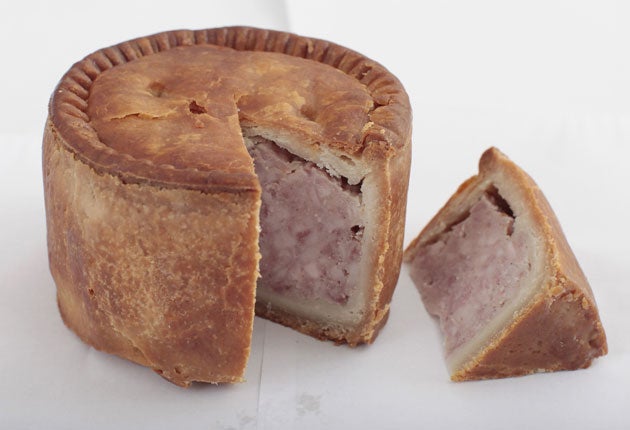The humble pork pie is reborn – as a luxury artisan foodstuff
It's no porky – demand for EU-protected 'heritage' pies is soaring

Your support helps us to tell the story
From reproductive rights to climate change to Big Tech, The Independent is on the ground when the story is developing. Whether it's investigating the financials of Elon Musk's pro-Trump PAC or producing our latest documentary, 'The A Word', which shines a light on the American women fighting for reproductive rights, we know how important it is to parse out the facts from the messaging.
At such a critical moment in US history, we need reporters on the ground. Your donation allows us to keep sending journalists to speak to both sides of the story.
The Independent is trusted by Americans across the entire political spectrum. And unlike many other quality news outlets, we choose not to lock Americans out of our reporting and analysis with paywalls. We believe quality journalism should be available to everyone, paid for by those who can afford it.
Your support makes all the difference.They were once a cheap snack shoved in farmhands' pockets to tide them through their long working days. But those times are long gone for the pork pie, which is enjoying a remarkable renaissance thanks to its reinvention as the ultimate in trendy snacks.
The pork pie, which had become a byword for heart disease, now graces the tables of the smartest metropolitan restaurants. Food experts credit its revived fortunes with a rejuvenated national appetite for local produce combined with a vast array of new takes on an old favourite from the country's burgeoning independent butchers sector.
Sales are climbing once again, based on measures of both value and volume. The pork pie market was worth £145m in the year to end of November 2010, up 4 per cent by value according to the market analysts Kantar Worldpanel. Chefs from Nigel Slater to Delia Smith have come up with new recipes for what Slater recently called "a thing of beauty". Restaurants including Butlers Wharf Chop House, in London, and the Kingham Plough, in Chipping Norton, Oxfordshire, have recently added pork pies to their menus.
Phil Vickery, the television chef who judged last year's Melton Mowbray category at the British Pie Awards, is among the snack's biggest fans – with one proviso: the pie must come from within the 1,800 square mile zone that earned the Melton Mowbray pork pie EU protection two years ago from imitation by rivals. He puts the snack's rebirth down to cooks using better, higher quality ingredients and fewer preservatives.
"To eat a Melton Mowbray pork pie with English mustard is one of life's great joys, provided the pastry is right. People are finally beginning to understand in Britain that you can get great food," Vickery said. He added that the ratio of pork to jelly to pastry was crucial, with the perfect pie being "at least 90 per cent pork" and around 6 to 8 per cent jelly.
Although the snack suffered from years of bad press at the hands of the anti-obesity brigade, its reinvention as a gastronomic treat has improved its image. Peter Charnley, secretary of the Pork Pie Appreciation Society, said: "It has perhaps less of a tag of being unhealthy and is instead something to savour and notice the difference between individual producers."
Chris Lamb, head of marketing at BPEX, which represents the pig industry, said that the recession had boosted the pies' comeback because it had given people a taste for "comfort food that we all have a positive association with". He added that a decline in eating out meant that people were more willing to spend "10p or so more on a premium pork pie".
Ben McCormack, editor of the restaurant guide Square Meal, said gaining EU protection had "raised awareness of the fact that pork pies are not just made out of pink luncheon meat stuffed into rock-hard pastry but can be a genuinely delicious artisan product with real heritage".
Marks & Spencer said its pork pie sales had surged over Christmas, with sales of Melton Mowbray pork pies growing by 35 per cent year on year.
Rob Farr, the retailer's pork pie buyer, said: "After the success we had over the festive season, we have decided to extend our range and launch some new flavours and twists. Lots of customers only eat them at Christmas, but we think they're too good to save for just once a year."
Culinary makeovers
Oysters Hard to fathom but the prized molluscs started life as a cheap, working-class snack, padding out the other ingredients in such belly-filling staples as beef and oyster pie.
Cornish pasties In their initial guise, these pastry snacks provided miners with fuel during their long, gruelling days. It was said you could drop one down a shaft and it would survive. It's unlikely the same is true of the premium versions now sold by a plethora of smart chains.
Faggots These British meatballs, made primarily from offal, were last popular when meat was scarce during the Second World War. That hasn't stopped chefs from featuring them on posh restaurant menus.
Brawn A meat dish made from the bits of a pig that don't even make it into sausages – offcuts from the head plus the trotters. It's now so trendy Brawn is even the name of a critically acclaimed new restaurant in east London.
Susie Mesure
Join our commenting forum
Join thought-provoking conversations, follow other Independent readers and see their replies
Comments